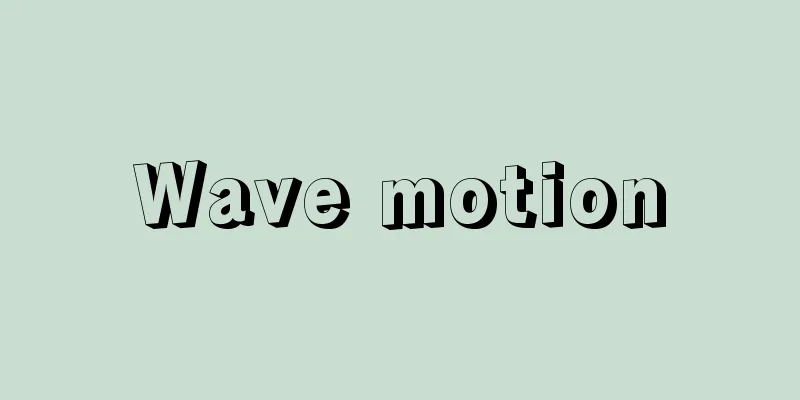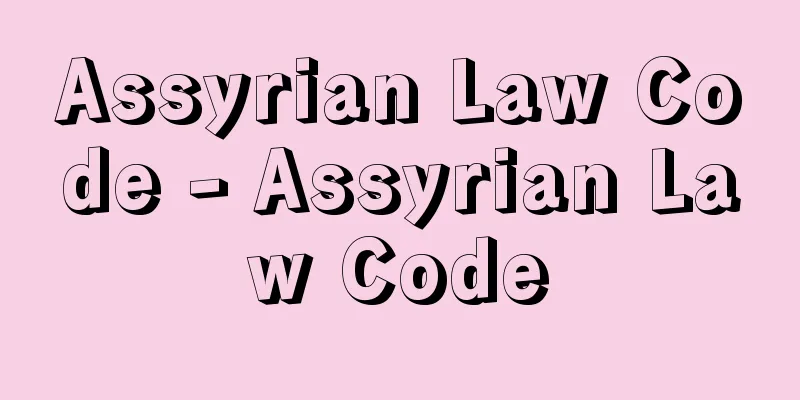Wave motion

|
A phenomenon in which a change in state applied to one part of a space or object is transmitted to the surrounding parts at a certain speed ( ). The waves on the surface of the ocean or a pond are a familiar phenomenon, but physically they are complex phenomena. These will be discussed in the "Waves" section. Examples of simple and basic waves that are easy to handle include transverse waves that travel along a string ( ), longitudinal waves of compression that travel along a coil spring ( ), sound waves that travel through a fluid, elastic waves (longitudinal and transverse waves) that are vibrations of an elastic body, and electromagnetic waves (including light waves) that travel in a vacuum or through a dielectric (insulator). Although their properties are somewhat different, there are also matter waves such as electron waves that are extremely important. Although each of these waves has its own individuality and uniqueness, they share similar properties as waves. Therefore, understanding the properties of one wave often helps to understand the properties of other waves. Below, we will mainly discuss transverse waves on a string. [Yoshiro Kainuma] Wave equation and wave functionIf a uniform, flexible string is stretched taut horizontally and one end of it is suddenly swung sideways, vibrations will travel along the string as transverse waves. The force acting on an infinitesimal portion of the string at a certain point (position coordinate x) is the resultant of two tensions exerted by the adjacent strings to the right and left. Since the two tensions have the same magnitude but slightly different directions, the resultant of the two tensions will be a restoring force that pulls this infinitesimal portion back to the position it would be when the string was taut and at rest (the equilibrium position). From the equation of motion for the infinitesimal portion of the string, "mass times acceleration equals force," we can derive a second-order partial differential equation called the wave equation (in one-dimensional space). In other words, "the product of (the square of the reciprocal of the wave propagation speed c) and (the second-order partial differential coefficient of the string's displacement u with respect to time t) is equal to (the second-order partial differential coefficient of the string's displacement u with respect to position x)." The solution u to this wave equation is a function of t and x and is called the wave function. The general form of the wave function u is the sum of any function of (tx/c) and any function of (t+x/c). The former represents a wave that propagates in the positive x direction, and the latter in the negative x direction, both at a speed of c. For a transverse wave on a string, the propagation speed c is equal to the square root of the ratio of the string tension to the linear density (the mass per unit length of the string). [Yoshiro Kainuma] Sine wave The sine wave ( ) is the most basic wave. The wave function u is u= a sin((2π/T)・(tx/c)+δ) [Yoshiro Kainuma] Wave EnergyWhen a wave propagates through a material, that material is called the wave's medium. When a traveling wave propagates, the medium simply vibrates around its equilibrium position, and the energy flow of the wave propagates along with the traveling wave. In a transverse wave of a string, an infinitesimal portion of the string has the kinetic energy of its vibration and the strain energy of the string's stretching deformation, which is based on the fact that the displacement changes depending on the location. The increase per unit time (increase rate) of the energy stored in an infinitesimal portion of the string is equal to the algebraic sum of the energy flows flowing in from both ends of this infinitesimal portion. The energy flow flowing in from a portion of the adjacent string through one end of the infinitesimal portion of the string is equal to the power (work per unit time) of the force that the adjacent string exerts on this portion. Therefore, it is equal to the product of the transverse component of tension and the string's velocity. [Yoshiro Kainuma] Wave reflection and transmission at the boundary between two media. In a transverse wave on a string, the ratio of the transverse component of tension to the string's velocity is equal to the square root of the product of tension and linear density (mass per unit length). This ratio is called the characteristic impedance of the string. Two strings of different linear densities are connected at one point. As the transverse wave travels along the first string, it is reflected at the boundary between the two strings, and a transmitted wave is transmitted to the second string. The ratio of the intensity of the reflected wave or transmitted wave to the intensity of the incident wave, i.e., the intensity reflectivity or intensity transmittance, is (intensity reflectivity) [Yoshiro Kainuma] Standing WaveWhen a sine wave travels along a string with one end fixed and reaches the fixed end, it is reflected with an amplitude reflection coefficient of minus 1. In other words, the amplitudes of the reflected wave and the incident wave are equal, but there is a phase jump of π (180 degrees). In this case, a standing wave is generated by the superposition of the two waves. In a standing wave, each point on the string vibrates at the frequency of the incident sine wave. At positions where the distance from the fixed end is an integer multiple of half the wavelength, a node is generated; that is, a place where the amplitude of the vibration is always zero. Halfway between adjacent nodes, an antinode is generated; that is, a place where the amplitude is maximum. At the nodes and antinodes of a standing wave, the energy flow is always zero, and the wave energy flows back and forth on the string between the closest nodes and antinodes ( ). [Yoshiro Kainuma] Synthetic WaveWhen two types of strings are connected, if the linear density of the second string is very large, a standing wave is generated with the connection point of the strings as the fixed end. Even if the linear density of the second string is very small, the intensity of the wave transmitted through the second string is close to zero, and a standing wave is generated with the connection point of the strings as the antinode ( ). This is close to the standing wave when the connection point is an open end (free end). Note that when the amplitudes of the incident sine wave and the reflected sine wave are different, the amplitude of the vibration at the node of the standing wave becomes a minimum, but does not become zero. [Yoshiro Kainuma] Plane wave/spherical waveWhen a wave travels through three-dimensional space, the plane along which the wave's phase remains constant is the plane that it travels along. This curved surface is called a wavefront. If the wavefront is a plane, the wave is a plane wave. If the wavefront is a sphere centered at a point, the wave is a spherical wave. The amplitude of a spherical wave decreases inversely proportional to the radius of the sphere, and the intensity decreases inversely proportional to the square of the radius. Therefore, the time-averaged total amount of energy flowing through a sphere is independent of the radius of the sphere. [Yoshiro Kainuma] Wave interferenceWhen two waves from a single source reach the same place via different paths, the two waves reinforce or cancel each other out, creating spatial stripes of varying strength. This phenomenon is called wave interference, and these stripes are called interference stripes. In general, there exists a wave whose wave function is equal to the sum of the wave functions of two waves. Therefore, it is possible to think of two waves as simply superimposed. This is the principle of wave superposition ( ). This principle provides the basis for wave optics (recent research has also been conducted on nonlinear optical phenomena that deviate from the principle of superposition). When two waves are superimposed and interfere with each other, the antinodes and nodes of a standing wave are created as mentioned above when the two waves travel in opposite directions. Below is an example of interference stripes of light waves. When a glass plate is pressed against the convex surface of a plano-convex lens and illuminated with monochromatic light, Newton's rings can be observed due to the interference of the light reflected from the top and bottom of the gap between the lens and the glass plate. Young's interference fringes can be observed by placing two narrow slits close together in a light-blocking plate and looking through them at a parallel slit placed in front of a monochromatic light source. If a rectangular glass plate is placed horizontally and a parallel slit is placed near the surface of the far end of the plate, illuminated with monochromatic light, and the near end of the plate is observed through a magnifying glass, Lloyd's mirror interference fringes can be observed. Michelson and Morley used a Michelson interferometer to observe the shift in interference fringes that would be expected from the Earth's orbital motion relative to the stationary ether, the medium of light, but did not observe the expected shift. This result was consistent with the principle of the constancy of the speed of light in Einstein's special theory of relativity. The Michelson interferometer and the Fabry-Perot interferometer were also used to calibrate the prototype meter using the wavelengths of atomic spectrum light (determining the correction values of the measuring instrument). The phenomenon of waves traveling through a medium can be explained as the superposition of secondary waves originating from each point on the wave front, and these secondary waves interfere with each other. This is called the Huygens-Fresnel principle (so named because the principle announced by C. Huygens of the Netherlands was expanded by Fresnel of France). The straight line propagation of waves through a uniform medium, and the reflection and refraction of waves at the boundary between two media can all be understood from the Huygens-Fresnel principle. [Yoshiro Kainuma] Wave DiffractionWhen light waves hit an apertured light-blocking plate, they are deflected into a geometrically-optical shadow space, and where direct light shines, diffraction fringes parallel to the edge of the aperture are produced. If the dimensions of the aperture are sufficiently large compared to the wavelength of the light waves, the diffraction phenomenon of light waves can be quantitatively explained by calculating the interference of secondary waves emitted from the wavefront of the light waves that reach the aperture of the light-blocking plate based on the Huygens-Fresnel principle. Diffraction phenomena of light waves are well known, such as diffraction by a single slit, diffraction by two slits lined up on a light-blocking plate, diffraction by a diffraction grating, and diffraction by atoms regularly arranged on a three-dimensional crystal lattice. The lens action of a Fresnel zone plate, the principle of holography, the resolution of a microscope, and the principle of phase-contrast microscopes are also examples of applications of diffraction of light waves. [Yoshiro Kainuma] Waves traveling through a tubeTubes are often used to transmit sound, electromagnetic, and light waves. Tubes used for this purpose are called waveguides for sound and electromagnetic waves, and optical fibers for light waves. Only plane waves of longitudinal waves can travel through narrow tubes, but when sound waves travel through thick tubes such as long corridors, tunnels, and underground passageways, complex waves that move in a zigzag pattern are transmitted in addition to plane waves. Electromagnetic waves in the microwave range that travel through metal waveguides are only waves that move in a zigzag pattern after being repeatedly reflected by the tube walls. Only waves with wavelengths shorter than the cutoff wavelength determined by the shape and dimensions of the tube can travel through such zigzag waves. Optical fibers are a type of glass fiber with a special structure, and light waves are transmitted by repeated reflections from its inner walls. Optical fibers are used to improve endoscopes used in medical examinations of the stomach and other internal organs. By selecting the right glass fiber material, it is possible to greatly reduce the attenuation of light waves due to absorption. Because of their properties, optical fibers are widely used for communication over long distances. [Yoshiro Kainuma] "Basic Physics Course II: Electromagnetism and Waves" by Kazuo Kimoto, Yoshiro Kainuma, and Akira Sugiyama (1979, Academic Book) [References] | | | | | | | principle©Shogakukan "> What is a wave? (Figure A) ©Shogakukan "> Transverse waves traveling along a string (Figure B) ©Shogakukan "> Longitudinal wave (Figure C) ©Shogakukan "> Wavelength and Amplitude of a Sine Wave (Figure D) ©Shogakukan "> Standing waves on a string (Figure E) ©Shogakukan "> Composite wave (Figure F) ©Shogakukan "> Wave interference (Figure G) Source: Shogakukan Encyclopedia Nipponica About Encyclopedia Nipponica Information | Legend |
|
空間や物体の一部に加えられた状態の変化が、次々に周囲の部分にある速さで伝わっていく現象()。海や池の水面にたつ波は親しみ深い現象であるが、これは物理的には複雑な現象である。これらについては「波浪」の項で述べる。 取り扱いやすく、簡単で基本的な波として、弦を伝わる横波()、つるまきばねを伝わる粗密の縦波()、流体中を進む音波、弾性体の振動の波(縦波および横波)の弾性波、真空中や誘電体(絶縁体)中を伝わる電磁波(光波を含む)などがある。いくらか性質が違うが、きわめて重要な波に、電子波のような物質波もある。これらの波には、それぞれの個性・独自性があるが、波として互いに類似した性質を共有する。それで、ある波の性質の理解は、しばしば他の波の性質の納得にも役だつことになる。以下では、主として弦の横波について述べる。 [飼沼芳郎] 波動方程式と波動関数一様でしなやかな弦をぴんと水平に張り、その一端を急に横に振ると、振動が横波として弦を伝わっていく。弦のある場所(位置座標x)の微小部分に働く力は、右および左に隣接する弦の及ぼす二つの張力の合力である。二つの張力は、同じ大きさ、わずかに異なる方向、逆の向きをもつので、二つの張力の合力は、この微小部分を弦がぴんと張って静止しているときの位置、(平衡位置)に引き戻す復元力となる。弦の微小部分の運動方程式、「質量掛ける加速度は力に等しい」から、(一次元空間の)波動方程式とよばれる二階の偏微分方程式が導かれる。すなわち、「(波の伝播(でんぱ)速度cの逆数の二乗)と(弦の変位uの時刻tによる二階偏微分係数)との積は、(弦の変位uの位置xによる二階偏微分係数)に等しい」。この波動方程式の解uはtとxの関数で波動関数とよばれる。波動関数uの一般的な形は、(t-x/c)の任意の関数と(t+x/c)の任意の関数の和である。前者はプラスx方向に、後者はマイナスx方向に、いずれも速度cで伝わる波を表す。弦の横波では、伝播速度cは弦の張力と線密度(弦の単位長さ当りの質量)との比の平方根に等しい。 [飼沼芳郎] 正弦波正弦波()はもっとも基本的な波である。波動関数uが [飼沼芳郎] 波のエネルギーある物質中を波が伝わっていくとき、その物質を波の媒質という。進行波が伝わっていくとき、媒質はその平衡位置を中心にして振動するだけで、進行波とともに伝わっていくのは波のエネルギー流である。弦の横波においては、弦の微小部分は、その振動の運動エネルギーと、変位が場所によって変化していることに基づく弦の伸び変形のひずみのエネルギーとをもつ。弦の微小部分に蓄えられたエネルギーの単位時間当りの増加量(増加率)は、この微小部分の両端から流れ込むエネルギー流の代数和に等しい。弦の微小部分の一端を通して隣接する弦の部分から流れ込むエネルギー流は、隣接する弦がこの部分に及ぼしている力の仕事率(単位時間にする仕事)に等しい。したがって、張力の横方向成分と弦の速度との積に等しくなる。 [飼沼芳郎] 2種の媒質の境界における波の反射と透過弦の横波において、張力の横方向成分と弦の速度の比は、張力と線密度(単位長さ当りの質量)との積の平方根に等しい。この比は弦の特性インピーダンスとよばれる。線密度の異なる2種類の弦を1点でつなぐ。第1の弦を横波が伝わっていくと、二つの弦の境界で波の反射がおき、第二の弦には透過波が伝わる。反射波、透過波の強度と入射波の強度の比、すなわち強度反射率、強度透過率は [飼沼芳郎] 定常波一端が固定されている弦に正弦波が伝わっていき固定端に到達すると、振幅反射率マイナス1で反射する。すなわち、反射波、入射波の振幅は等しく、位相にはπ(180度)の跳びを生ずる。この場合には、二つの波の重ね合わせによって定常波が生ずる。定常波では弦の各点が入射正弦波の振動数で振動する。固定端からの距離が半波長の整数倍になる位置に節(ふし)、すなわち振動の振幅がつねにゼロになる場所が生ずる。隣り合った節と節の中間に腹(はら)、すなわち振幅最大の場所が生ずる。定常波の節および腹ではエネルギー流がつねにゼロであり、もっとも近接した節と腹の間にある弦の上で波のエネルギー流が往復している()。 [飼沼芳郎] 合成波2種類の弦がつながれているとき、第二の弦の線密度が非常に大きい場合は、弦の接続点を固定端とする定常波が生ずる。第二の弦の線密度が非常に小さい場合にも、第二の弦に透過する波の強度はゼロに近く、弦の接続点を腹とする定常波が生ずる()。これは、接続点を開放端(自由端)とする場合の定常波に近いものである。なお入射正弦波と反射正弦波の振幅の大きさが異なる場合には、定常波の節における振動の振幅は最小にはなるが、ゼロにはならない。 [飼沼芳郎] 平面波・球面波三次元空間を伝わる波においては、波の位相が一定値をとる平面が伝わっていく。この曲面を波面という。波面が平面であれば、波は平面波である。波面が1点を中心とする球面であれば、波は球面波である。球面波の振幅は球面の半径に逆比例して減少し、強度は半径の二乗に逆比例して減少する。したがって、球面を通して流れるエネルギー流の総量の時間平均は球面の半径によらぬことになる。 [飼沼芳郎] 波の干渉一つの波源から出た波が異なる経路をたどって同一の場所に到達すると、二つの波は強め合ったり相殺したりして波の強弱の縞(しま)が空間的に生ずる。この現象が波の干渉で、この縞は干渉縞である。一般に、二つの波の波動関数の和に等しい波動関数で表される波が存在する。したがって、二つの波をそのまま重ね合わせて考えてもよいことになる。これが、波の重ね合わせの原理である()。この原理は波動光学の基礎を与える(最近は、重ね合わせの原理から外れた非線形光学現象も研究されている)。二つの波の重ね合わせ、干渉は、二つの波の進行方向の向きがちょうど逆のときには既述のように定常波の腹と節を生ずる。以下に、光波の干渉縞の例をあげる。平凸レンズの凸面にガラス板を押し付けて、単色光で照らすと、レンズとガラス板の間隙(かんげき)の上面・下面からの反射光の干渉により、ニュートン環が観察される。一枚の遮光板に互いに接近した二つの狭いスリットを並べてつくり、これを通して単色光源の前に置かれた平行なスリットを見ると、ヤングの干渉縞が観察される。短冊形のガラス板を水平に置き、その向こう側の端のガラス板の表面近くにこれに平行なスリットを置き、単色光で照らし、そしてガラス板の手前側の端を拡大鏡で観察すると、ロイドの鏡による干渉縞が見られる。 マイケルソン、モーリーは、マイケルソン干渉計を用いて、光の媒質、静止エーテルに対する地球の公転運動から期待できる干渉縞のずれの観測をしたが、期待されたずれは観察されなかった。これは、アインシュタインの特殊相対性理論の光速不変の原理と一致する結果であった。マイケルソン干渉計、ファブリ‐ペロー干渉計は、原子スペクトル光の波長によるメートル原器の較正(こうせい)(測定器の補正の値を決定すること)にも利用された。 波が媒質中を伝わっていく現象は、波面の各点を源とする二次波の重ね合わせがおき、これらの二次波が互いに干渉するとして説明できる。これをホイヘンス‐フレネルの原理という(オランダのC・ホイヘンスが発表した原理をフランスのフレネルが拡張したので、このようによばれる)。一様な媒質中における波の直進、二つの媒質の境界面における波の反射・屈折は、みなホイヘンス‐フレネルの原理から理解できる。 [飼沼芳郎] 波の回折光波が開口した遮光板にぶつかると、光波は幾何光学的な影の空間へ回り込み、また直射光の照らすところには、開口のへりに平行な回折縞が生ずる。光波の波長に比して開口の寸法が十分に大きければ、遮光板の開口に到達した光波の波面から出る二次波の干渉をホイヘンス‐フレネルの原理に基づいて計算することにより、光波の回折現象を定量的に説明することができる。一つのスリットによる回折、遮光板上に並んだ二つのスリットによる回折、回折格子による回折、三次元の結晶格子上に規則正しく並んだ原子による回折などの光波の回折現象はよく知られている。フレネル帯板のレンズ作用、ホログラフィーの原理、顕微鏡の分解能、位相差顕微鏡の原理なども、光波の回折の応用例である。 [飼沼芳郎] 管の中を伝わる波音波・電磁波・光波を伝送するために管を利用することがしばしばある。これに用いる管は、音波・電磁波の場合には導波管、光波の場合には光学繊維または光ファイバーとよばれる。狭い管の中を伝わる音波は縦波の平面波だけであるが、長い廊下やトンネルや地下の連絡道のような太い筒の中を音波が伝わるときには、平面波だけでなく、筒の内壁で繰り返し反射を受けてジグザグに進む複雑な波が伝わっていく。金属の導波管を伝わるマイクロ波領域の電磁波は管壁で繰り返し反射を受けてジグザグに進む波だけである。管の中をジグザグに進むこのような波は、管の形状と寸法によって定まる遮断波長よりも短い波長の波だけが伝わる。光ファイバーは特殊な構造をもつ一種のグラスファイバーであり、その内壁の繰り返し反射で光波が伝わる。光ファイバーは胃その他の内臓の医学的検査に用いる内視鏡の改良に用いられている。グラスファイバーの材質を選べば、吸収による光波の減衰をきわめて小さくすることができる。その特性のため、光ファイバーは長距離間の通信に広く用いられる。 [飼沼芳郎] 『紀本和男・飼沼芳郎・杉山旭著『基礎物理学講座Ⅱ 電磁気・波動』(1979・学術図書)』 [参照項目] | | | | | | |©Shogakukan"> 波とはなにか〔図A〕 ©Shogakukan"> 弦を伝わる横波〔図B〕 ©Shogakukan"> 縦波〔図C〕 ©Shogakukan"> 正弦波の波長と振幅〔図D〕 ©Shogakukan"> 弦にできる定常波〔図E〕 ©Shogakukan"> 合成波〔図F〕 ©Shogakukan"> 波の干渉〔図G〕 出典 小学館 日本大百科全書(ニッポニカ)日本大百科全書(ニッポニカ)について 情報 | 凡例 |
Recommend
Movie actor
〘 noun 〙 A person whose occupation is to appear in...
Katakura Silk Mills
…In 1895, the family formed an anonymous associat...
Ehagoita - Ehagoita
...Hago (hago) and koginoko (kogino ko) are the f...
Genki
[1747-1797] A painter from the mid-Edo period. sou...
"The Tale of the Great Master of the Seas' Eastern Expedition"
…Completed in 779 (10th year of the Hōki era). It...
Breastfeeding - Chitsuke
The first time a newborn baby is breastfed. In the...
Ezo Banryudo Cave
...Rice farming is the mainstay of agriculture, b...
Yellow crucian carp
A regional brand of the Kanto region, Tochigi Pref...
fathom
...Units of length that are said to originate fro...
Wood rose - Kibara
…So, rather than sticking to the traditional syst...
Benzonitrile
A colorless liquid with a benzaldehyde-like odor. ...
Sekimono - Sekimono
A sword made by a swordsmith in Seki, Mino Provinc...
Winter moth (winter scale) - Winter moth
An insect of the Geometridae family of the Lepidop...
Bulgakov, Mikhail Afanas'evich
Born: May 15, 1891, Kyiv [Died] March 10, 1940. Wr...
Amud Cave - Amud Cave
An archaeological site on the shores of Lake Tiber...



![Urawa [city] - Urawa](/upload/images/67cb01416648f.webp)





